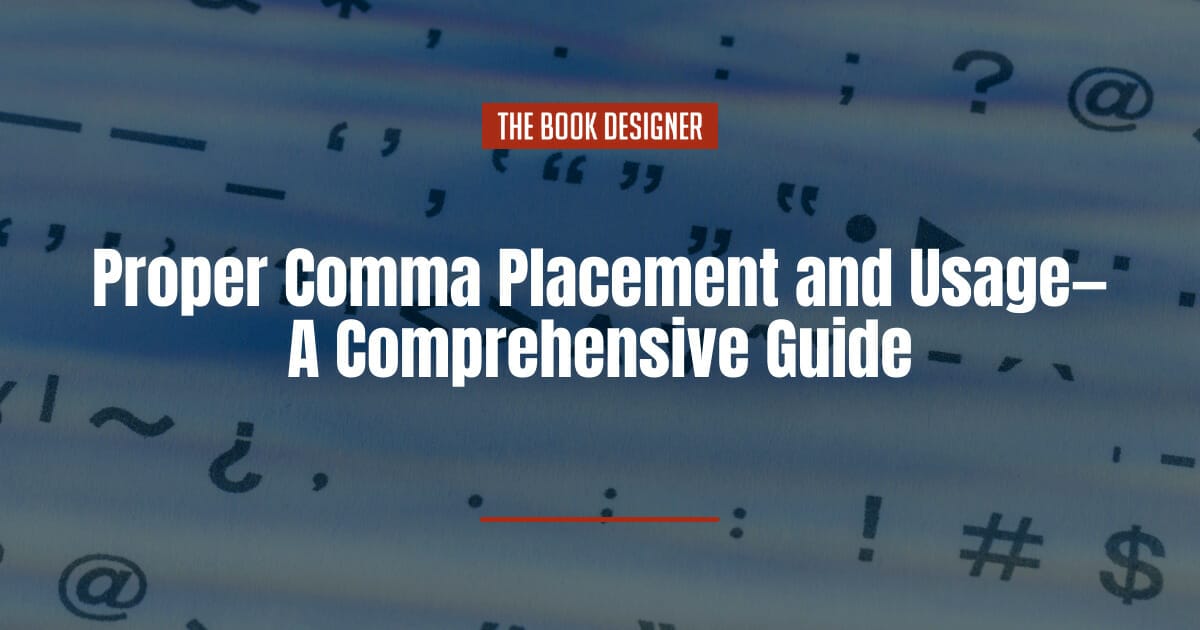As omnipresent and inconspicuous as the comma is in the English language, it’s surprisingly common to see it misplaced and misused.
After all, there’s an abundance of circumstances surrounding whether or not you should use commas, where you should use them, and how their usage and placement could drastically change the meaning of your sentence.
Trust us, we understand just how confusing the comma can be!
That’s why we’ve assembled this comprehensive punctuation guide to comma usage, the grammar behind it, and exactly where to put your commas to make your writing clear and concise.
When determining proper comma placement, consider:
Comma Placement with Subjects and Verbs
As a general rule of thumb, a comma should never be placed so that it separates a subject from its verb. For example, note the incorrect comma placement in the sentence:
My brother Gerry, comes home from college this week.
This one might seem relatively simple, but many writers feel inclined to place commas wherever a speaker would naturally pause. In writing, though, this reasoning often makes the sentence appear choppy and incohesive, as you can observe in the above example. Instead, the same sentence should be written as follows:
My brother Gerry comes home from college this week.
Now, if Gerry is the writer’s only brother, then the sentence would be written as follows:
My brother, Gerry, comes home from college this week.
In this case, including “Gerry” is not necessary to the meaning of the sentence and can be set inside comments to indicate that.
Note: It’s important to pay attention to this rule when writing particularly long or detailed sentences.
Two Nouns in a Compound Subject/Object
While this one may seem fairly obvious as well, it’s surprisingly common to see two nouns separated by a comma when no comma is actually necessary. For example, note the comma placement in this sentence:
All I brought to class was my textbook, and my laptop.
The subjects, being “textbook” and “laptop,” are compounded by the addition of the word “and.” As the writer is simply listing two items, a comma isn’t necessary. The sentence should read as follows:
All I brought to class was my textbook and my laptop.
Two Verbs in a Compound Predicate
Simply put, a compound predicate appears when the subject of your sentence is doing multiple things. When there are two verbs present in the same sentence, you don’t need to add a comma so long as they both belong to the same subject. Incorrect comma placement with a compound predicate appears as such:
The puppy raced around the yard, and chased after her tennis ball.
Since both the verbs “raced” and “chased” belong to the same subject (“the puppy”), you don’t need to add a comma in the middle of the predicate. The sentence should be written as follows:
The puppy raced around the yard and chased her tennis ball.
The most frequent misuse of commas in this instance comes when the predicate consists of a longer, complex verb phrase. For example, note the comma placement in the sentence:
I wanted to go grocery shopping today, but left my list at home.
While a natural pause may occur here when one is speaking, the written form doesn’t require a comma since the compound predicate still belongs to the same subject. Rather, it should read:
I wanted to go grocery shopping today but left my list at home.
Comma Splices
A comma splice is a simple error that appears when you combine two independent clauses with a comma rather than a conjunction or a semicolon. It can look something like this:
We were going on a road trip, I filled up the gas tank.
Technically, both of these clauses could stand alone, but if you’re choosing to combine them, you need either a conjunction or a semicolon in order to avoid a comma splice. The sentence could be rewritten correctly in one of three ways:
- We were going on a road trip. I filled up the gas tank.
- We were going on a road trip, so I filled up the gas tank.
- We were going on a road trip; I filled up the gas tank.
Interrupters and Parenthetical Elements
Interrupters are phrases that can be added to the middle of a sentence to express opinion, emphasis, or emotion. They should always be set off with commas both before and after. For example:
The outdoor concert, to my disappointment, was postponed due to inclement weather.
Similarly, parenthetical elements are phrases that supplement the information included in a sentence yet aren’t integral to the sentence’s meaning. These should also be set off with commas.
Carmen, to my surprise, arrived on time today.
Appositives
An appositive is a reference to a noun that appears earlier in the same sentence. Appositives provide additional information about that subject. There are two types of appositives: essential and nonessential.
Essential appositives are necessary to the integrity of the sentence’s content; they can’t be removed without drastically altering the meaning of the sentence. These are not set off with commas.
Leo Tolstoy’s novel War and Peace is one of my favorites.
Nonessential appositives aren’t necessary to the sentence but are used to provide additional information about the subject. These are set off with commas. For example:
My English professor, Dr. Carlton, always assigns us homework.
Coordinate Adjectives
Sometimes multiple adjectives are used to describe the same noun to the same degree. These are called coordinate adjectives and should always be separated by commas. You can easily identify these by switching the order of the adjectives; if the sentence still makes sense, they’re coordinate!
Oxford Comma
When you’re listing three or more items, you should separate each item with a comma. However, the comma between the final item and the “and” is called the Oxford (or serial) comma, and may or may not be used depending on which style guide you’re adhering to. Both of the following sentences are grammatically correct:
- I went to the library, the bakery, and the antique store today. (Correct in Chicago Style.)
- I went to the library, the bakery and the antique store today. (Correct in AP Style.)
In general, the Oxford comma provides clarity in sentences like this. While the particular example above is clear with or without the Oxford comma, there are other instances where it’s necessary to discern the meaning. In fact, there was a court case involving Oakhurst Dairy and their delivery drivers where the absence of an Oxford comma in a state law ended up costing the company $10 million. The sentence read:
The canning, processing, preserving, freezing, drying, marketing, storing, packing for shipment or distribution of:
- Agricultural produce;
- Meat and fish product; and
- Perishable foods
Because of the lack of comma between “shipment” and “or” the court ruled that “packing for shipment or distribution” was a single activity rather than “packing for shipment” and “distribution” being two separate activities. Because of this, the delivery drivers were deemed to be entitled to overtime pay.
For anyone who says the Oxford comma is purely a stylistic choice, it can be vital to making your meaning clear.
Nonrestrictive Clause
Simply put, a nonrestrictive clause is nonessential information about something you’ve mentioned in a sentence; the clause could be removed without altering the meaning of the sentence. These should always be set off by commas. For example:
Downtown Donuts, where my sister works, is always busy in the morning.
Restrictive Clauses
Contrary to nonrestrictive clauses, restrictive clauses provide essential information that can’t be removed without changing the sentence’s meaning. These should never be set off by commas, and appear as such:
The book that Sophie recommended is definitely worth reading!
While there are many rules surrounding the proper usage of commas, they don’t have to be as mystifying as they first appear. This breakdown offers some of the common uses and misuses of commas and how to not only avoid them but correct them should you ever come across them in your writing. Learning the ins and outs of the English language may seem like quite a daunting task, but we hope we helped make it easier and more achievable through this guide.




